 W
WThe Amazing Vacation is a children's fantasy novel written in 1956 by Dan Wickenden, illustrated by Erik Blegvad. It is very rare, with fewer than 50 copies available in libraries. It is fondly remembered by children of the era, and has been cited by authors as one of the formative books of their childhood.
 W
WAnd the Rain My Drink is a 1956 novel by Chinese-Flemish writer Han Suyin. Set against a backdrop of the Malayan Emergency of the late 1940s and 1950s, it describes the methods used by the British colonial authorities and by the left-wing rebels, and how individual lives were affected.
 W
WAssignment: Murder is a thriller novel by Donald Hamilton.
 W
WBadge of Evil is a novel written by Whit Masterson and published in 1956. This novel was the basis for the 1958 movie Touch of Evil, directed by Orson Welles and co-starring Charlton Heston and Janet Leigh.
 W
WBang the Drum Slowly is a novel by Mark Harris, first published in 1956 by Knopf. The novel is the second in a series of four novels written by Harris that chronicles the career of baseball player Henry W. Wiggen. Bang the Drum Slowly was a sequel to The Southpaw (1953), with A Ticket for a Seamstitch (1957) and It Looked Like For Ever (1979), completing the tetralogy of baseball novels by Harris.
 W
WBlack Fox of Lorne is a 1956 children's historical novel written and illustrated by Marguerite de Angeli. This Newbery Honor Book is about tenth-century Viking twins who shipwreck on the Scottish coast and seek to avenge the death of their father. They encounter loyal clansmen at war, kindly shepherds, power-hungry lairds, and staunch crofters.
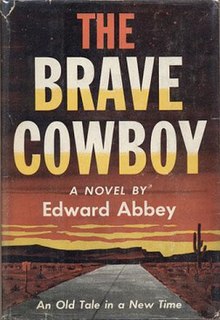 W
WThe Brave Cowboy (1956) was Edward Abbey's second published novel.
 W
WChocolates for Breakfast is a 1956 American novel written by Pamela Moore. Originally published in 1956 when Moore was eighteen years old, the novel gained notoriety from readers and critics for its frank depiction of teenage sexuality, and its discussion of the taboo topics of homosexuality and gender roles. The plot focuses on fifteen-year-old Courtney Farrell and her destructive upbringing between her father, a wealthy Manhattan publisher, and her mother, a faltering Hollywood actress.
 W
WCompulsion is a 1956 crime novel by the American writer Meyer Levin. Set in the 1920s, it is inspired by the real-life Leopold and Loeb trial, and was a bestseller. Two college students kidnap and kill a boy in order to prove they can get away with the perfect crime.
 W
WCop Hater (1956) is the first 87th Precinct police procedural novel by Ed McBain. The murder of three detectives in quick succession in the 87th Precinct leads Detective Steve Carella on a search that takes him into the city's underworld and ultimately to a .45 automatic aimed straight at his head.
 W
WThe Crossroads of Time is a science fiction novel by American writer Andre Norton, first published in 1956 by Ace Books as one of their double novels. The story takes its protagonist through several versions of Earth as it might have been if history had gone differently. The book has been translated into Spanish, Italian, and German.
 W
WThe Cup of Fury is a 1956 non-fiction work by Upton Sinclair describing how alcohol affected the lives of many writers including Jack London, Ben Hecht and Hart Crane.
 W
WDanny Dunn and the Anti-Gravity Paint is the first novel in the Danny Dunn series of juvenile science fiction/adventure books written by Raymond Abrashkin and Jay Williams. The book was first published in 1956 and originally illustrated by Ezra Jack Keats.
 W
WDon't Go Near the Water is a 1956 novel by William Brinkley. The book parodies aspects of the wartime United States Navy, particularly Navy public relations, in which Brinkley served, propaganda, war correspondents, civilian contempt for the regular military, and Naval Intelligence.
 W
WDouble Star is a science fiction novel by American writer Robert A. Heinlein, first serialized in Astounding Science Fiction and published in hardcover the same year. It received the 1956 Hugo Award for Best Novel.
 W
WThe Dragon in the Sea (1956), also known as Under Pressure from its serialization, is a novel by Frank Herbert. It was first serialized in Astounding magazine from 1955 to 1956, then reworked and published as a standalone novel in 1956. A 1961 2nd printing of the Avon paperback, catalog # G-1092, was titled 21st Century Sub with the previous title in parentheses, and a short 36 page version of the novel was later collected in Eye. It is usually classified as a psychological novel.
 W
WThe Field of Vision is a 1956 novel by Wright Morris, written in the style of high modernism. It won the U.S. National Book Award for Fiction in 1957.
 W
WFifteen is a juvenile fiction novel written by Beverly Cleary. It was first published in 1956. It chronicles the perspective of a teenage girl entering her first romantic relationship. The book captures the innocent spirit of life in the 1950s, both through the playfully light storyline and the casual references to convertibles, sweaters, "meeting boys", and soda shops. Regardless, the book remains in print today because its overall theme of difficult adolescent feelings still connects with young readers.
 W
WThe Floating Opera is a novel by American writer John Barth, first published in 1956 and significantly revised in 1967. Barth's first published work, the existentialist and nihilist story is a first-person account of a day when protagonist Todd Andrews contemplates suicide.
 W
WForbidden Area is a 1956 Cold War thriller novel by Pat Frank. Its plot involves Soviet sleeper agents intended to sabotage the U.S. war effort, who have been trained by classical conditioning to have an American "cover identity" that they can remember as well as their own.
 W
WFreddy and Simon the Dictator (1956) is the 24th book in the generally humorous children's series Freddy the Pig written by American author Walter R. Brooks and illustrated by Kurt Wiese. It tells how animals in New York State rebel against humans, destroying property and taking control of farms. At the same time, Freddy’s friend Mr. Camphor is pressured into running for governor. The situations collide when animals take over Camphor’s estate, imprisoning the political figures there.
 W
WGiovanni's Room is a 1956 novel by James Baldwin. The book focuses on the events in the life of an American man living in Paris and his feelings and frustrations with his relationships with other men in his life, particularly an Italian bartender named Giovanni whom he meets at a Parisian gay bar.
 W
WA Girl, A Man, and a River (1957) is a mystery story by John and Ward Hawkins which was originally written as a seven-part serial for the Saturday Evening Post and published in issues from January 21, 1956 until March 3, 1956. It was later published as a hardcover book The Floods of Fear by Dodd Mead/Penguin Putnam in 1956.
 W
WThe Hidden Window Mystery is the thirty-fourth volume in the Nancy Drew Mystery Stories series. It was first published in 1956 under the pseudonym Carolyn Keene. The actual author was ghostwriter Harriet Stratemeyer Adams.
 W
WHighways in Hiding is a science fiction novel by American writer George O. Smith. It was published in 1956 by Gnome Press in an edition of 4,000 copies. The novel was originally serialized in the magazine Imagination in 1955. An abridged version was published by Avon Books in 1957 under the title Space Plague.
 W
WThe House of Sixty Fathers is a children's novel by Meindert DeJong first published in 1956. Illustrations were provided by Maurice Sendak. The novel was based on the author's own experiences as a military flier in China during the second world war.
 W
WThe Hunters is James Salter's debut novel and a tale of USAF fighter pilots during the Korean War, first published in 1956. The novel was the basis for the 1958 film adaptation of the novel starring Robert Mitchum and Robert Wagner with a different storyline.
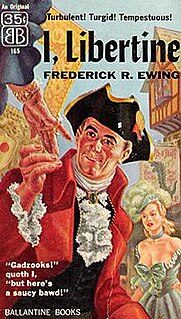 W
WI, Libertine is a literary hoax novel that began as a practical joke by late-night radio raconteur Jean Shepherd.
 W
WImperial Woman is a novel by Pearl S. Buck first published in 1956.
 W
WThe Last Hurrah is a 1956 novel written by Edwin O'Connor. It is considered the most popular of O’Connor's works, partly because of a 1958 movie adaptation starring Spencer Tracy. The novel was immediately a bestseller in the United States for 20 weeks, and was also on lists for bestseller of that year. The Last Hurrah won the 1955 Atlantic Prize Novel award, and was highlighted by the Book-of-the-Month Club and Reader's Digest. The Last Hurrah received very positive critical reviews, including an "ecstatic" one from the New York Times Book Review.
 W
WLucky Starr and the Big Sun of Mercury is the fourth novel in the Lucky Starr series, six juvenile science fiction novels by Isaac Asimov that originally appeared under the pseudonym Paul French. The novel was first published by Doubleday & Company in March 1956. Since 1972, reprints have included a foreword by Asimov explaining that advancing knowledge of conditions on Mercury has rendered some of the novel's descriptions of that world inaccurate.
 W
WLucy Crown is a novel by American author Irwin Shaw. First published in 1956, it was Shaw's third novel, following The Young Lions and The Troubled Air.
 W
WMad River is a western novel by Donald Hamilton.
 W
WThe Man Who Japed is a science fiction novel by American writer Philip K. Dick, first published in 1956. Although one of Dick's lesser-known novels, it features several of the ideas and themes that recur throughout his later works. The "jape[s]" or practical jokes of the novel begin with a statue's unconventional decapitation.
 W
W"The Man Who Studied Yoga", a novella by Norman Mailer written in 1952, was first published in the 1956 collection New Short Novels 2 then later in Mailer's 1959 miscellany Advertisements for Myself (AFM). It is a tale of a "writer manqué", or a writer who fails to write, reflecting some of Mailer's own anxiety in the 1950s as he tries to reinvent himself.
 W
WMight as Well Be Dead is a Nero Wolfe detective novel by Rex Stout, published by the Viking Press in 1956. The story was also collected in the omnibus volume Three Aces.
 W
WMiracles on Maple Hill is a 1956 novel by Virginia Sorensen that won the 1957 Newbery Medal for excellence in American children's literature. The book was illustrated by Beth and Joe Krush.
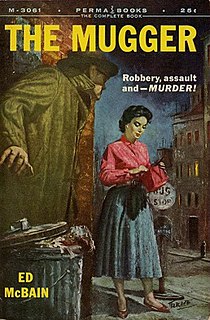 W
WThe Mugger is a (1956) novel by Ed McBain, the second in his 87th Precinct series. It was adapted for a film of the same name in 1958. In 2002 the author wrote an introduction to this and to his earlier novel Cop Hater when both were published in an omnibus edition.
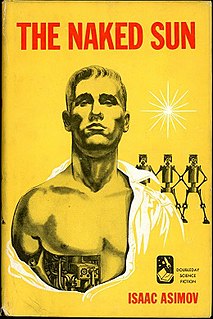 W
WThe Naked Sun is a science fiction novel by American writer Isaac Asimov, the second in his Robot series. Like its predecessor, The Caves of Steel, this is a whodunit story. It was first published in book form in 1957 after being serialized in Astounding Science Fiction between October and December 1956.
 W
WNever the Same Again is a 1956 Bildungsroman by Jerry Tschappat, written under the name Gerald Tesch.
 W
WThe Nun's Story is a 1956 novel by Kathryn Hulme. It was a Book of the Month selection and reached #1 on The New York Times Best Seller list.
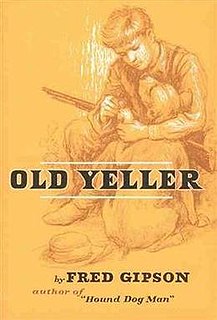 W
WOld Yeller is a 1956 children's novel written by Fred Gipson and illustrated by Carl Burger. It received a Newbery Honor in 1957. The title is taken from the name of the yellow dog who is the center of the book's story. In 1957, Walt Disney released a film adaptation starring Tommy Kirk, Fess Parker, Dorothy McGuire, Kevin Corcoran, Jeff York, and Beverly Washburn.
 W
WPatrick Butler for the Defence, first published in 1956, is a detective story by American writer John Dickson Carr, which features Carr's series detective Patrick Butler. This novel is a mystery of the type known as a whodunnit.
 W
WPeyton Place is a 1956 novel by American author Grace Metalious. The novel describes how three women are forced to come to terms with their identity, both as women and as sexual beings, in a small, conservative, gossipy New England town, with recurring themes of hypocrisy, social inequities and class privilege in a tale that includes incest, abortion, adultery, lust and murder. It sold 60,000 copies within the first ten days of its release and remained on The New York Times best seller list for 59 weeks.
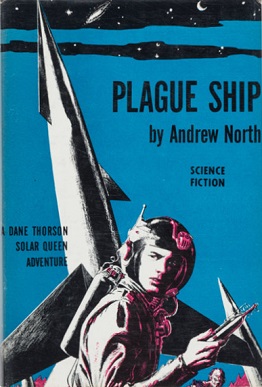 W
WPlague Ship is a science fiction novel by Andre Norton under the pseudonym Andrew North. It was published in 1956 by Gnome Press in an edition of 5,000 copies. The book is the second volume of the author's Solar Queen series.
 W
WThe Power is a 1956 science fiction novel by American writer Frank M. Robinson. It first appeared in the March 1956 edition of Blue Book magazine and then in a standalone book published by J. B. Lippincott in May that year. Its protagonist, a researcher named Tanner, discovers evidence of a person with psychic abilities among his coworkers. As he tries to uncover the superhuman, his existence is erased and his associates murdered, until he faces a showdown with an apparently invincible opponent.
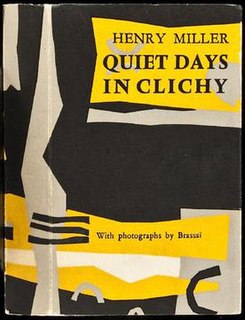 W
WQuiet Days in Clichy is a novella written by Henry Miller. It is based on his experience as a Parisian expatriate in the early 1930s, when he and Alfred Perlès shared a small apartment in suburban Clichy as struggling writers. It takes place around the time Miller was writing Black Spring. According to his photographer friend George Brassaï, Miller admitted the title is “completely misleading.”
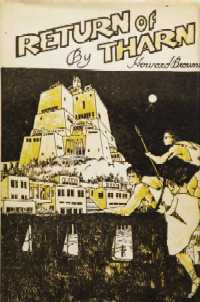 W
WThe Return of Tharn is a fantasy novel by American writer Howard Browne. It was first published in book form in 1956 by The Grandon Company in an edition of 500 copies, although 150 of the copies were lost to flood damage and perhaps another 150 show some water damage.
 W
WSeize the Day, first published in 1956, is Saul Bellow's fourth novel. It was adapted into the film of the same name.
 W
WThe Shrinking Man is a science fiction novel by American writer Richard Matheson, published in 1956. It has been adapted into a motion picture twice, called The Incredible Shrinking Man in 1957 and The Incredible Shrinking Woman in 1981, both by Universal Pictures. The novel was retitled The Incredible Shrinking Man in some later editions.
 W
WSilver Canyon is a novel written by Louis L'Amour set in south-central Utah Territory in 1881. It was originally published in a shorter version, named Riders of the Dawn, in the magazine Giant Western in June 1951. It then was published in hardback in 1956 by Avalon Books and in paperback by Bantam Books in 1957.
 W
WSlave Ship is a 1956 short science fiction novel by American writer Frederik Pohl, originally serialized in Galaxy. The scene is a world in the throes of a low-intensity global war, which appears to be an amplified representation of the Vietnam War, in which the U.S. was just beginning to be involved. The plot involves telepathy, speaking to animals, and, in the last few pages, an invasion by extraterrestrials.
 W
WThe Stars My Destination is a science fiction novel by American writer Alfred Bester. Set in the 24th or 25th century, which varies between editions of the book, when humans have colonized the Solar System, it tells the story of Gully [Gulliver] Foyle, a teleporter driven by a burning desire for revenge.
 W
WThe Barbarous Coast was Ross Macdonald’s sixth Lew Archer novel. It was published by Alfred A. Knopf in 1956, and by Bantam Books as a paperback. It takes an acid view of South Californian society that foreshadows Macdonald's later treatment of cross-generational deterministic themes.
 W
WTime for the Stars is a juvenile science fiction novel by American writer Robert A. Heinlein, published by Scribner's in 1956 as one of the Heinlein juveniles. The basic plot line is derived from a 1911 thought experiment in special relativity, commonly called the twin paradox, proposed by French physicist Paul Langevin.
 W
WTo Live Forever is a science fiction novel by American writer Jack Vance, first published in 1956. In the Vance Integral Edition, it was retitled Clarges.
 W
WVolcano Adventure is a 1956 children's book by the Canadian-born American author Willard Price featuring his "Adventure" series characters, Hal and Roger Hunt. It depicts a journey to several of the world's most dangerous volcanoes. The story involves the brothers meeting a volcanologist and deals with volcanology, perhaps one of the more scientific of Price's novels.
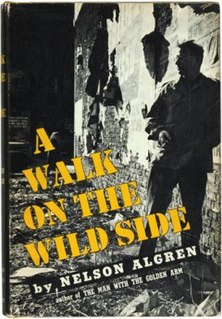 W
WA Walk on the Wild Side is a 1956 novel by Nelson Algren, also adapted into the 1962 film of the same name. Set in Depression era, it is "the tragi-comedy of Dove Linkhorn", a naive Texan drifting from his hometown to New Orleans.
 W
WThe World Jones Made is a 1956 science fiction novel by American writer Philip K. Dick, examining notions of precognition, humanity, and politics. It was first published by Ace Books as one half of Ace Double D-150, bound dos-à-dos with Agent of the Unknown by Margaret St. Clair.